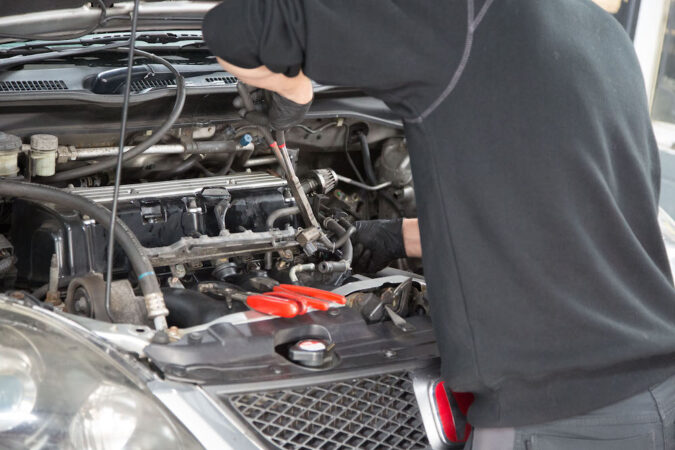Experiencing a pesky engine misfire can be a frustrating ordeal, especially when it affects a specific cylinder like cylinder 5. A misfire occurs when the combustion process fails to complete properly in a particular cylinder, leading to reduced engine performance, rough idling, and decreased fuel efficiency. If you’ve diagnosed a cylinder 5 misfire issue in your vehicle, don’t fret! This comprehensive guide will empower you with the knowledge and step-by-step instructions to troubleshoot and resolve the problem effectively.

Image: www.youtube.com
What Causes Cylinder 5 Misfire?
Pinpointing the exact cause of cylinder 5 misfire requires a systematic approach and keen attention to detail. Here are some of the most common culprits:
1. Faulty Spark Plug or Ignition Coil:
The spark plug responsible for igniting the air-fuel mixture in cylinder 5 could be faulty or worn out, resulting in ignition failure. Similarly, the ignition coil that supplies voltage to the spark plug might be malfunctioning.
2. Fuel Injector Issues:
A clogged or malfunctioning fuel injector could starve cylinder 5 of the necessary fuel, leading to a misfire.

Image: www.motorverso.com
3. Compression Loss:
If the cylinder’s valves or piston rings wear out or sustain damage, compression loss can occur, resulting in insufficient pressure for proper combustion.
4. Vacuum Leak:
A vacuum leak in the intake manifold or hoses can disrupt the air-fuel mixture, affecting the combustion process in cylinder 5.
5. Faulty Wiring or Electrical Connections:
Loose or damaged electrical connections or wiring can prevent the proper flow of current to the ignition components, leading to a misfire.
Step-by-Step Troubleshooting Guide
To effectively resolve the cylinder 5 misfire, a methodical approach is crucial. Follow these steps for a comprehensive troubleshooting process:
1. Basic Visual Inspection:
Begin by inspecting the spark plug, ignition coil, and wiring harness connected to cylinder 5. Look for signs of corrosion, loose connections, or damage.
2. Spark Test:
Using a spark plug tester, check if the spark plug is producing a strong and consistent spark. If the spark is weak or intermittent, replace the spark plug.
3. Ignition Coil Test:
Measure the resistance of the ignition coil using a multimeter. Compare the reading with the manufacturer’s specifications. If the resistance is out of range, replace the coil.
4. Fuel Injector Test:
Use a fuel pressure gauge to check the fuel pressure at the rail. Listen for any unusual noises or leaks coming from the fuel injector. Consider cleaning or replacing the injector if necessary.
5. Compression Test:
Use a compression tester to measure the compression pressure in cylinder 5. Compare the reading with the other cylinders. If the compression is significantly lower, it may indicate valve or piston ring issues.
6. Vacuum Leak Check:
Spray a carburetor cleaner around the intake manifold and hoses while the engine is running. If the engine speed changes or the misfire worsens, it indicates a vacuum leak.
Resolving the Misfire Issue
Once the root cause of the cylinder 5 misfire has been identified, you can proceed with the necessary repairs:
1. Replacing Spark Plug or Ignition Coil:
If the spark plug or ignition coil is faulty, replace it with a new one. Ensure the spark plug gap is set correctly according to the manufacturer’s specifications.
2. Cleaning or Replacing Fuel Injector:
Clean the fuel injector using an injector cleaner or replace it if cleaning proves ineffective.
3. Addressing Compression Loss:
If compression loss is the issue, valve or piston ring replacement may be necessary. This repair requires specialized expertise and is best left to a qualified mechanic.
4. Fixing Vacuum Leak:
Locate and seal any vacuum leaks using appropriate sealant or by replacing damaged components.
5. Repairing Electrical Connections:
Secure loose connections, repair damaged wires, and replace faulty components to restore proper electrical flow.
How To Fix Cylinder 5 Misfire
Conclusion
Resolving a cylinder 5 misfire requires a systematic approach to troubleshooting and repair. By following the steps outlined in this comprehensive guide, you can effectively diagnose and fix the issue, ensuring optimal engine performance and fuel efficiency. Remember, if you encounter any complexities during the process, don’t hesitate to consult a qualified mechanic for professional assistance.